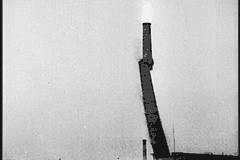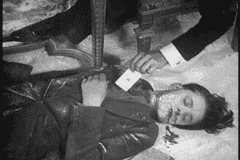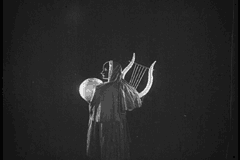Blood of a Poet (Jean Cocteau) 1933
 Jean Cocteau, who would later go on to direct such classics as Testament
of Orpheus and Beauty and the Beast began with this short
(50min.) non-narrative film. Blood of a Poet explores the figurative
and literal blood and sweat that goes into creating a work of art. The film
starts with an image of a tall chimney as it starts collapsing (an image that
will now probably be impossible to separate from the World Trade Center
collapsing) and then shifts to view an artist that is painting a portrait.
This artist becomes, for a while, the protagonist, and we follow him as as he literally becomes one with his art (the
portrait's mouth attaches itself to his hand), then falls into the world on the
other side of the mirror (where he sees such things as an opium den and a child
being whipped and ordered to take flight), and as he eventually shoots himself
in the head to receive "eternal glory", and is immortalized in the
form of a statue.
Jean Cocteau, who would later go on to direct such classics as Testament
of Orpheus and Beauty and the Beast began with this short
(50min.) non-narrative film. Blood of a Poet explores the figurative
and literal blood and sweat that goes into creating a work of art. The film
starts with an image of a tall chimney as it starts collapsing (an image that
will now probably be impossible to separate from the World Trade Center
collapsing) and then shifts to view an artist that is painting a portrait.
This artist becomes, for a while, the protagonist, and we follow him as as he literally becomes one with his art (the
portrait's mouth attaches itself to his hand), then falls into the world on the
other side of the mirror (where he sees such things as an opium den and a child
being whipped and ordered to take flight), and as he eventually shoots himself
in the head to receive "eternal glory", and is immortalized in the
form of a statue.
 The film then moves to a schoolyard setting where the statue of the artist is
sitting, as a snowball fight erupts. The children's fight literally leaves the
statue deconstructed, and one young child is knocked out and left bloody afterwards.
Next, the schoolyard reveals itself not as reality, but as a stage, with noble spectators that applaud
the display. A poet and a woman begin to play cards. The woman tells the poet
"If you do not have the Ace of Hearts, then you are lost." The poet,
realizing he doesn't have it, pickpockets it from the unconscious boy. Then the
boy's guardian angel appears, covers the boy, and takes back his Ace. The poet,
without the Ace, has indeed lost, so he opts to kill himself. The crowd applauds
his sacrifice. The woman reveals herself to
be Death, and wanders off talking of the mortal desire for immortality. We then
see the chimney from the film's start collapse completely, suggesting the
artist's dilemma lasted only a few seconds.
The film then moves to a schoolyard setting where the statue of the artist is
sitting, as a snowball fight erupts. The children's fight literally leaves the
statue deconstructed, and one young child is knocked out and left bloody afterwards.
Next, the schoolyard reveals itself not as reality, but as a stage, with noble spectators that applaud
the display. A poet and a woman begin to play cards. The woman tells the poet
"If you do not have the Ace of Hearts, then you are lost." The poet,
realizing he doesn't have it, pickpockets it from the unconscious boy. Then the
boy's guardian angel appears, covers the boy, and takes back his Ace. The poet,
without the Ace, has indeed lost, so he opts to kill himself. The crowd applauds
his sacrifice. The woman reveals herself to
be Death, and wanders off talking of the mortal desire for immortality. We then
see the chimney from the film's start collapse completely, suggesting the
artist's dilemma lasted only a few seconds.
 The film is exceptionally vivid. The imagery used here is still stunning
despite its low-tech nature. The film's implication that the artist must exploit
his childhood and experience for inspiration (signified as the Ace of Hearts is stolen), that
the artist must view the world as a distortion (viewable through all the bizarre
images on display), and that both artistic integrity and fame come at a great
price (signified by the multiple suicides in the name of "glory") are
all never explicitly stated, but are deeply felt here. The film is
as good as any that I've seen at evoking the inner state of the director's mind.
It is exceptional in its evocation of the artist's dilemma, and anyone with an
analytical mind would find plenty to digest here.
The film is exceptionally vivid. The imagery used here is still stunning
despite its low-tech nature. The film's implication that the artist must exploit
his childhood and experience for inspiration (signified as the Ace of Hearts is stolen), that
the artist must view the world as a distortion (viewable through all the bizarre
images on display), and that both artistic integrity and fame come at a great
price (signified by the multiple suicides in the name of "glory") are
all never explicitly stated, but are deeply felt here. The film is
as good as any that I've seen at evoking the inner state of the director's mind.
It is exceptional in its evocation of the artist's dilemma, and anyone with an
analytical mind would find plenty to digest here.
September, 2001
**** Masterpiece
Jeremy Heilman